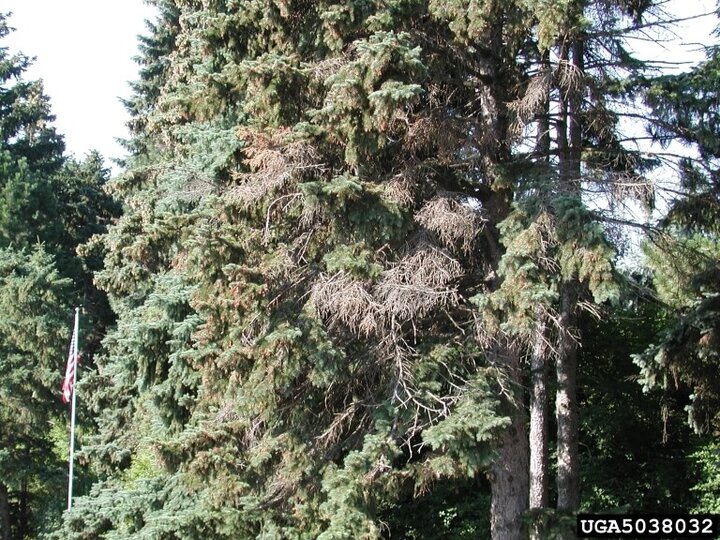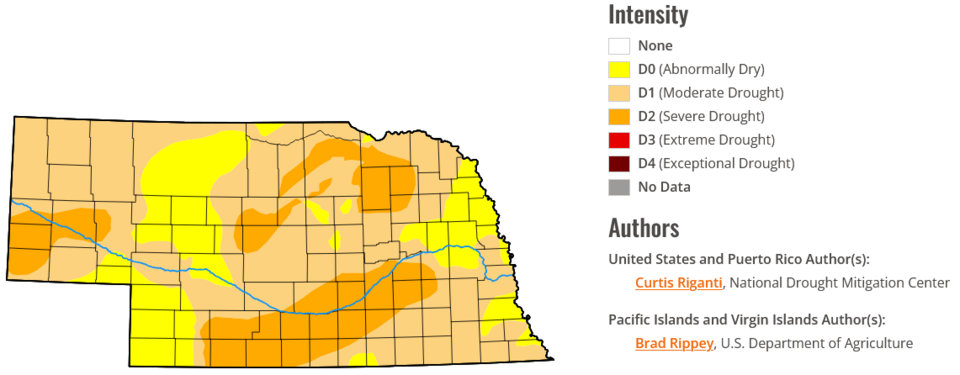
Seasonal information for Nebraska's green industry professionals.
Going In-depth
1. Canker Diseases of Trees - What canker diseases are in your trees and what you can do to prevent them.
2. July 1st growing degree days (GGD) - Several Nebraska sites below, Understanding Growing Degree Days
3. Pest update - Pests to watch for based on growing degree days (GGC)
Research You Can Use
4. Fall Webworm, Michigan State University Extension
Greener Landscapes - Conservation & Climate Change Mitigation in Action
5. Working with Native Plants Continues to Trend Across the Gardening Industry
Timely Topics
6. Weeds in the lawn and landscape
7. Biting Insects
8. Avoid turf fertilization
For Your Information
9. Commercial/Non-commercial pesticide applicator certification - Obtaining a new license or updating an expired license.
10. Digital Diagnostic Network - Need help with diagnostics? - Submit pictures and questions for diagnosis by Nebraska Extension experts.
ProHort Update Newsletter
ProHort Update is a FREE monthly e-mail newsletter from Nebraska Extension, providing timely information to green industry professionals.
SubscribeNebraska's drought status, 6/26/2025

Upcoming Events
1. Canker Diseases of Trees
Canker diseases of trees infect trunks and branches leading to branch die back and eventual tree death. There are no chemical treatments for cankers making prevention key in protecting trees.
A “canker” is an infected area of a branch or trunk where cell tissue (xylem and phloem) is killed interfering with water and food movement in the tree. The branch or trunk portion beyond the canker can exhibit leaf browning (scorch), yellowing, and die back. The cankered area may be discolored, sunken or raised. It may also be cracked around the dead area or across it. Some cankers ooze sap or bacteria or develop pathogen fruiting bodies on their surface, others are not visible outside the tree at all.
Cankers are caused by a fungi or bacteria. Most pathogens are unable to penetrate bark directly, making vigorous, healthy trees better able to avoid them. Canker pathogens take advantage of stressed or wounded trees, entering trees via natural openings or wounds made by people, insects, wind and hail.
Prevention: Avoid tree stress and tree wounds. Select the right tree for the site and do not plant too deep. Protect tree trunks from mowers and weed trimmers with correct mulching. Use timely pruning so branches are removed at smaller diameters, leaving behind a smaller wound. Remove branches that will eventually rub against and wound another branch. Avoid pruning trees during stressful periods like drought.
Limited moisture is a common stress. Relying only on automatic irrigation systems for trees is not adequate in dry years. Most irrigation systems run too frequently and apply too little water each time to water trees adequately. They do not moisten soil deep enough to fully benefit trees, while keeping the upper soil levels too wet which reduces oxygen recharge of soil. During dry years, irrigate trees to moisten the soil to a depth of 12 to 18 inches, in the area from the trunk to the dripline all the way around the tree, about once a month.
Dealing with Cankers: If the canker is on a branch, the best practice is to prune it out. If the canker is large and the entire branch is affected, remove the entire branch during the dormant season with a good pruning cut made outside the branch bark ridge and collar, if possible.
If the canker is small and the entire branch does not need to be removed, prune out the affected section at least 8 inches back into healthy tissue. Cut back to another branch to redirect new growth and so a branch stub is not left behind. Removing cankered branches helps slow spread to other branches or trees. Sterilize pruning tools between cuts. If the canker is on a tree’s main trunk, pruning can still be done, but options are more limited.
Common Cankers and Resources:
Fireblight (fruit trees, crabapple, ornamental pear)
Hypoxylon Canker (Poplars, aspen)
Diplodia Tip Blight and Canker (pine, spruce)
2. July 1st growing degree days (GDD)
| Location | Accumulated Growing Degree Days |
| Grand Island, NE - Airport | 1281 |
| Lincoln, NE - Airport | 1443 |
| Omaha, NE - Airport | 1442 |
| Norfolk, NE - Airport | 1181 |
| North Platte, NE - Airport | 967 |
| Scottsbluff, NE - Airport | 972 |
3. Pest update
| GDD (base 50) | Insect | Lifestage present at this GGD |
|---|---|---|
| 600-900 | Bagworm | Larvae appear |
| 850-900 | Mimosa webworm | 1st generation egg hatch |
| 850-900 | Fall webworm | Egg hatch |
| 930 | Lilac borer | 1st generation hyaline stage |
| 950-2150 | Japanese beetle | Adult emergence |
| 1000-2000 | Emerald ash borer | Peak adult emergence |
| 1200-1800 | Fall webworm | Caterpillars feeding |
| 1250 | Codling moth | 2nd generation control stage |
| 1375 | American plum borer | 2nd generation |
| 1500 | Pine needle scale | 2nd generation control stage |
| 1700 | Zimmerman pine moth | adult flight |
| 1800-2200 | Banded ash clearwing | adult emergence |
| 1850-2025 | Fall webworm | Tents become apparent |
| 1925-1950 | Magnolia scale | Egg hatch |
For a more complete list, visit Michigan State University GGD of Landscape Insects or GGD of Conifer Insects.
4. Fall Webworm, Michigan State University Extension
It is July, so we are getting close to the emergence of Fall Webworm. The caterpillars can be found feeding when we hit 1200-1800 Growing Degree Days, it typically shows up in August in Southeastern Nebraska. Fortunately, we know that Fall webworms are not terribly damaging to trees, but your clients will not like the look of them in their trees. Here is a great article from Michigan State University Extension to help you prepare for the client calls on dealing with it in their trees.
5. Working with Native Plants Continues to Trend Across the Gardening Industry
Homeowners are increasingly curious about native options, though some remain cautious. Native plants can have a reputation for spreading across the landscape, sometimes giving them a “weedy” appearance. However, with the right selections, you can recommend native plants that are both attractive and well-behaved—perfect for gardeners new to natives.
One effective strategy is to highlight yellow and purple combinations, which add bold, eye-catching contrast to any garden. These colors naturally draw attention to each plant, making the garden vibrant and dynamic. For extra interest, incorporate height and interesting foliage textures.
Here are four native plants to consider recommending:
- Oxeye Sunflower (Heliopsis helianthoides): A smaller-stature, long-blooming perennial with bright yellow flowers that last for weeks.
- Prairie Purple Clover (Dalea purpurea): A low-growing native with airy foliage and striking purple blooms that attract pollinators.
- Purple Poppy-mallow (Callirhoe involucrata) and Missouri Evening Primrose (Oenothera macrocarpa): Both act like ground covers, filling in the understory with vibrant, contrasting blooms when planted together.
All four of these native plants are becoming more readily available in many garden centers and pair well together in the landscape. Once established, they require minimal management and only supplemental water during prolonged droughts, making them a sustainable choice for gardeners seeking beauty with lower maintenance.
6. Weeds in the lawn and landscape
There are a lot of weeds going strong this summer. Honeyvine milkweed (Cynachum laeve), is a native perennial vine that can be friend and a pest. Leaves are heart shape and appear as pairs. The tap root can extend downwards to six or more feet. It is best pulled by hand in the home garden. Vines can grow up to 10 feet long. Honeyvine Milkweed article from Iowa State University Extension and Outreach
Common lambsquarters (Chenopodium album), is a common weed in the garden. Seeds can remain viable in the soil for decades. It is becoming herbicide resistant and is best pulled by hand. Try to avoid allowing the plant to flower and set seed. Common Lambsquarters article from Wisconsin Horticulture Division of Extension
Black medic (Medicago lupulina) is blooming right now with bright yellow flowers. This annual weed does well in drought and nutrient poor soils. Because it can tolerate low mowing heights it often is not managed by mowing. Seeds germinate in the fall or early winter. Black Medic article from Purdue University
7. Biting Insects
Chiggers, Ticks, and Mosquitoes are commonly found this time of year, especially as we spend the majority of time outside in most cases. All of these insects post some threat, ticks and mosquitoes can spread diseases and chiggers can cause an itchy reaction. If clients ask questions about biting insects like chiggers, ticks and mosquitoes, below are one page fact sheets about management they can be provided with or referred to:
- Chiggers, Nebraska Extension
- Mosquitoes, Nebraska Extension
- Ticks, Nebraska Extension
8. Avoid turf fertilization in summer
Fertilization of cool season turfgrass is best avoided during July and August. It promotes leafy growth at the expense of roots and increases irrigation needs as well as susceptibility to heat, drought and pests, like brown patch disease. If needed, avoid applying fertilizer to drought-stressed or dormant turf, or when temperatures are over 80F. Select a slow-release nitrogen source. While more expensive, these rarely burn leaf blades even when applied at temperatures above 85F. Calibrate spreaders to be sure the correct rate is applied. Maintain a mowing height of 3 to 3.5 inches and use sharp mower blades.
9. Commercial/Non-commercial pesticide applicators
If you have a pesticide applicators license which expired in April 2025 or you need to get a new license, testing options are listed below.
Testing-only Options
- Closed-book exams are given by the Nebraska Department of Agriculture (NDA). Preregistration is not required and there is no cost. Visit the link below for a list of available test-only dates, times and locations - https://pested.unl.edu/.
- NDA computer-based testing is provided through the Pearson-Vue company. Click here for a list of testing sites, categories available, dates, and registration information. Cost $55 per exam. (For applicators with multiple categories on their license, each category is charged the full testing fee.)
2025 Commercial/non-commercial training was held from January through April. Training schedules are available at https://pested.unl.edu/. Help your employees be successful at getting a license by purchasing study materials.
10. Digital Diagnostic Network - Need help with diagnostics?
Do you or your clients have questions you need help answering? Maybe you are a lawn care person and they're asking about trees, shrubs, or flowers? While you can refer them to their local Extension office, another option is Digital Diagnostic Network. Homeowners, lawn care professionals, pest control operators and others are invited to submit questions and photos through this website or with the assistance from an Extension professional at any Nebraska Extension office. All offices are equipped with high-resolution digital image capturing technology. Whether the question is about a lawn weed, insects on a plant, diseases in a shrub border or other, an expert panel of Extension professionals will review and respond to the question. To get started, create an account so the question can be reviewed and responded to via email. For more information and to create an account, go to Digital Diagnostic Network.
Bugging Out With Your Camera Phone - Tips on how to get a good picture.
Reference to commercial products or trade names is made with the understanding that no discrimination is intended and no endorsement by Nebraska Extension is implied. Use of commercial and trade names does not imply approval or constitute endorsement by Nebraskas Extension. Nor does it imply discrimination against other similar products.
Continuing Issues
Fruits & Vegetables
Trees & Shrubs
- Emerald Ash Borer Resources - EAB has been found in several Nebraska locations. Homeowners are encouraged to wait to begin treating their ash trees until the insect is confirmed within 15 miles of their location.
- NFS Tree Storm Damage Resources